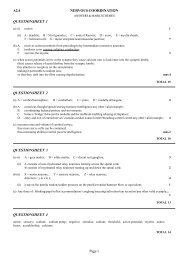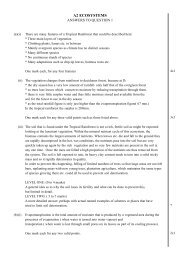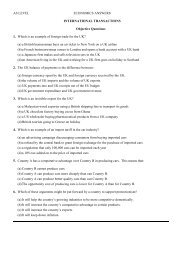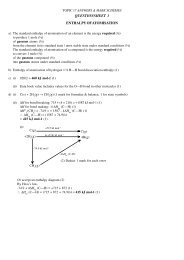Answers
Answers
Answers
Create successful ePaper yourself
Turn your PDF publications into a flip-book with our unique Google optimized e-Paper software.
A2 ECONOMIC ACTIVITYANSWERS TO QUESTION 1(a)Table One shows that:* Primary industry has decreased over the whole period from 22% to 2 %* This change in the primary industry was quite rapid from 1851 to 1891 as the industrialrevolution was under way and people were leaving the countryside to work in factories in towns.It has been more gradual since 1931.* Secondary activities stayed about the same level until 1971. They were 49% in 1851 andincreased slightly to 53% in 1891 and 1911 but after 1911 they decreased slowly to 45% in 1971.* After 1971 there was a rapid fall of 20% as many of the heavy industries started to decline for avariety of reasons such as increased competition from abroad etc.* Numbers employed in the tertiary industries have increased over the period.* There was a slow increase to 1911 and then a marked one to 1931 which could be linked withthe introduction of public transport or an increase in the leisure and retail industries at that time.* There was a fall in service industries in the 1930s and 1940s perhaps connected with aneconomic depression or involvement in the Second World War* There was a rapid increase between 1971 and 1991.* A new group of activities, the quaternary industries appeared for the first time as an employer in1991. These were the jobs linked to the new technological ideas which were introduced in the1980s e.g. computers etc.LEVEL ONE: ( 0 to 3 marks)Some basic descriptions of the data given but little if any explanation.LEVEL TWO: ( 4 to 6 marks)Several descriptive comments on the data but also an attempt to give some reasons for the changesseen.6(b)Graphs One and Two show that over a period of 15 years the numbers of people employed inmanufacturing industry has fallen whilst the number in services has increased. This istrue for both the UK as a whole and the West Midlands which was a prosperous industrialregion during the 1960s and 1970s. Deindustrialisation is a process which occurs in advancedindustrial countries, such as the UK and the USA, which have had many heavy industries in thepast. These industries started to decline in the late 1970s for a variety of reasons such ascompetition from foreign countries etc. At the same time there was a sharp increase in serviceactivities such as banking, insurance, and finance as this sector of the economy started tobecome more important.From the graphs deindustrialisation seems to have been occurring to a marked extent in the UKwith a fall in the numbers employed in manufacturing. There was a concentration of employmentin the tertiary activities, for which the UK was starting to gain a world-wide reputation.Up to two marks for descriptive comments on the graphs, with a further one mark for therecognition of the changes as being due to deindustrialisation and a final mark for adefinition of the term.4
(c)Deindustrialisation has occurred in the UK over the last 20 to 30 years.The main characteristics of the process were:* firstly the closure of heavy industries such as iron and steel , engineering, shipbuilding, etc.i.e. those that were found in the old industrial areas.* these industrial areas were often linked with coalfields which had also started to decline.* later, other industries were affected and even areas which had thrived until now started to decline.Reasons for deindustrialisation:* Competition from foreign companies who started to produce the same products at lower costsand thus prices. This was because the UK industries were rather out-dated, with uneconomiclocations and factory sizes compared to some of the industries in the new industrial countries ofthe developing world.* Coal had been the main power base for the development of industry in the UK but by the late1970s and 1980s in many areas it was becoming costly to mine as the supplies were deeper orless easy to reach. In some areas supplies were running out and mines were being closed as theywere uneconomical to run.* Technological change such as computerised machines and industrial robots reduced the need forworkers. Unskilled workers are usually the worst affected by such changes as they are the oneswhose jobs are more easily automated.* Another cause has been the rise of the service sector which now employs more people.* This rise in numbers of jobs in the service sector is largely due to changes in our society as wedemand more service facilities, such as those linked with leisure and tourism.* Also with the increasing globalisation of the economy more financial and office services areneeded. These can often afford to pay higher wages and offer better working conditions than inthe factories and so are more attractive to workers.LEVEL ONE: ( 0 to 3 marks)A very basic idea of the process and an answer that is descriptive rather than explanatory.LEVEL TWO: (4 to 7 marks)A more detailed understanding of the process with some explanatory points.LEVEL THREE: ( 8 to 10 marks)A good detailed account with many explanatory points indicating a thorough knowledgeof the process. 10Total 20
A2 ECONOMIC ACTIVITYANSWERS TO QUESTION 2(a)The government departments are located:*in urban areas for a readily available source of labour.*in many parts of the UK and spread to provide employment in regions of high unemployment.*mainly in lowland areas e.g. none in Central Wales, Northern Scotland as accessibility andlabour supply could be a problem here.*none in Northern Ireland as security could be difficult with some of the departments.One of the main reasons for the pattern of distribution is a policy of decentralisation i.e. thegovernment decided to move certain central offices out of London in order to:*reduce congestion and limit further growth there.*reduce the unemployment problems of some of the areas to which they were moved e.g. Girobankin Liverpool and the DHSS in Newcastle provided jobs for the local people who lost their jobs afterthe decline of coal-mining and/or heavy industries.*reduce the widening gap between the prosperous south-east and the less wealthy regional areas.Improved technology (e.g. faxes and computers) made it easier to communicate so location is lessimportant. Services have become more footloose.2x1(b)One mark each for any descriptive point up to a total of three. One mark each for an explanatorypoint up to a maximum of three.Any manufacturing industry could be chosen here:General factors:* Proximity to desired energy source* Raw materials* Labour supply* Good transport links*Lower rates/rents*Government policyFor example: The chemicals industry (e.g. I.C.I Billingham). This industry has the followinglocational factors:*works are usually on major estuaries because:*the industry needs to import many of its raw materials (e.g. oil pipeline from Echo Fisk oilfieldto Teeside)*it can dispose of waste products into the river,*it can use water from the river as a coolant in various processes*it can take water from the river to use as a raw material.*works are usually near to densely populated urban areas for a workforce. However, they are nottoo near because of the risk of accidents involving gases and chemicals.*works need to be near major roads or motorways for the distribution of the products (e.g.I.C.I. Billingham is close to A174 trunk road).*works need to be be near to their bulky raw materials in order to reduce transport costs e.g. inthe north east the chemicals industry at Billingham is near to a coalfield, supplies of limestoneand various salts. It is also near to the oil from the North Sea which is piped onshore to nearbyrefineries, partly processed and then used in the manufacture of various products.*works need to be near major populated areas as local markets reduce transport costs for theirbulky products. There is one chemical industry near to each of the major coastal conurbations.3x1
*on a local scale, large areas of flat land are needed as the works often cover a large area and needto be all on one level if possible. Boulder clay bedrock absorbs vibrations in factory.*also the land needs to be as cheap as possible e.g. the undrained marshy areas often found alongriver estuaries are ideal here, as once drained they provide cheap sites on land that no-one elsewants. e.g. Stanlow Refinery along the Mersey estuary.LEVEL ONE: ( 0 to 3 marks )A basic account which is more descriptive than explanatory.LEVEL TWO: ( 4 to 6 marks )A more detailed account with several locational factors described and explained.LEVEL THREE: ( 7 to 8 marks )A thorough understanding of most of the locational factors is shown. An annotated sketch map willprobably be included.8x1(c)The following factors would be considered by the managing director:*Location within the UK:The south and east of England along the M4 corridor, along the M11 to Cambridge or M3 toHampshire which have existing hi-tech industries would be favourable. Silicon Glen in Fife maybe considered.*Location within the local area:Nearness to a town, perhaps on a new industrial estate or science park, would also be advantageous.Availability of labour and good communications links are important.The reasons for selecting these areas would be:Within the UK:*there are many other firms in these areas and hi-tech firms benefit from proximity to each other(synergy).*these areas have a high quality environment e.g. pleasant green countryside. This is important, aswhen siting a footloose industry such as this, in which transport costs are relatively unimportant,such an environment attracts well-qualified employees.*the areas are near to London, the financial and business capital of the country, which is usefulfor maintaining contacts with the headquarters of other companies. Employees are attracted byLondon’s facilities (e.g. West End theatres).*the areas have the M11 or M4 as the main means of communication. These motorways are alsolinked to the rest of the UK's network and the Channel Tunnel.*the areas are also near to international airports (such as Heathrow) which are needed for exportand foreign contacts and allow rapid access to Europe.*they are also near to many universities and research establishments. Research can be carried outbefore new products are developed. Qualified workers are attracted from universities (e.g. inSandwich courses).The site on a science park is good because:*there is already an existing infrastructure e.g. motorway connections etc.*the new factory would be near to other businesses e.g. components factories.*the landscaped environment produces pleasant working conditions which attract skilled workers.LEVEL ONE: ( 0 to 4 marks )A basic account of the areas which would be most suitable.LEVEL TWO: ( 5 to 7 marks )A more detailed account including many location factors - local as well as nationwide.7Total 20
A2 ECONOMIC ACTIVITYANSWERS TO QUESTION 3(a)(b)(c)The data in Table One shows that:* there were considerable differences between the areas in the growth of manufacturingover the 25 year period.* there were also quite large differences in the relative proportions of world manufacturingoutput for each of the regions in 1970, from East Asia with 4.2 % to Africa south of theSahara with 0.5%.* East Asia had the largest growth over the 25 year period, nearly trebling its percentageof world manufacturing.* South Asia had increased its manufacturing by about 25% of its figure in 1970 by 1995but even then had the second lowest value of all the areas given.* South America's values increased sharply in 1980 but sank to below their 1970 value by 1990.* North Africa and the Middle East had grown by about one third of their 1970 value by 1995.* Africa South of the Sahara had the lowest value all through the period and decreasedmarginally from 1970 to 1995.One mark each for any relevant descriptive point.Newly Industrialising countries (NICs) had experienced rapid economic growth in the yearsshown.Table Two shows that South Korea grew in such a way because:* its GDP started to increase rapidly in the middle of the 1980s.* its industrial production followed a similar pattern with a rapid increase since 1987.The figures for overseas investment are also typical of an NIC. From the early 1990s many NICsstarted to globalise their operations, opening factories in the USA, Europe and the rest of Asia.By doing this the Korean firms were able to avoid some of the trade barriers which suchcountries operated against Korean imports.Up to two marks for a link between the meaning of NICs and the data shown in Table Two.Two marks reserved for an understanding of the idea of globalisation and overseas investment asshown in Table Three.The Tiger Economies have certain industrial characteristics. The factors favouringtheir growth are:* a good, cheap labour supply. This is the most important factor. Workers are prepared towork hard and for long hours often in poor conditions. Wages are very low compared to therest of the world.* good, cheap sea transport is readily available in these countries. The use of containers totransport their many products to foreign markets is very important.* good markets: the USA faces many of these countries on the Pacific Rim, Australia is to thesouth and home markets within Asia are increasing as the countries develop.* the governments work hard to support their industries. They welcome foreign capital andtechnology to further their development, and also put up many barriers to discourage foreignimports and encourage the sale of the products of their industries.The types of industries that are set up in these countries are:* heavy industries such as steel, ships, and petrochemicals, which are vital to their economicgrowth and development.* light industries such as electrical goods and clothes* hi-tech electronics industries such as making computers.7x16
The last two groups are examples of high-value goods which are excellent for exporting overlong distances.The problems that have occurred in such countries have included:* high levels of pollution: industrial development has occurred very rapidly and as yet the newfactories are not governed by pollution control laws.* strikes: increasingly workers are starting to rebel against the low wages and poor conditions.It is these low wages that are keeping production costs down and allowing prices to be keptcompetitive even though the goods often have to be moved long distances to markets.* the rapid industrialisation has sometimes meant that goods are faulty or less reliable than thoseproduced elsewhere, which initially earned some firms bad reputations.* Over-extended borrowing and lack of financial control led to crashes.LEVEL ONE: ( 0 to 4 marks)A basic account with only one or two factors and types of industry. Problems briefly described,if at allLEVEL TWO: ( 5 to 8 marks)A more detailed account with many factors and problems included.LEVEL THREE: ( 9 to 12 marks)A very thorough account, indicating a good knowledge of the industrial geography of suchcountries, perhaps using named examples to illustrate certain points.12Total 25
A2 ECONOMIC ACTIVITYANSWERS TO QUESTION 4(a) (i)Between 1950 and 1997 the world car production figures:* increased seven-fold.* increased by the largest amount, ten and a half millions, between 1960 and 1970.There are several possible reasons for the changing production:* the greater increases at the beginning of the period given could be linked to a general increase inliving standards which meant that car-ownership was within the reach of more people.* the slower increase in more recent years could be due to the fact that the market in the MEDCsis now saturated and as yet the vast numbers of people in the LEDCs are unable to afford afamily car.* the slower increase could also be due to more environmental awareness of the pollution riskslinked with excess numbers of cars on the road and also the fears that oil supplies may startto run out.One mark each for up to three descriptive points and one mark each for up to three reasons forthe pattern of growth shown.(ii) Graphs One and Two show the world's leading car producers in 1950 and 1997.The main comparisons are:* there are 4 main producers in 1950 but 9 in 1997.* the USA was by far the largest producer in 1950 with 85%, but in 1997 was the secondlargest with only 15%.* Japan was not listed in 1950 but was the leading producer in 1997 with 24%.* South Korea was also a new car producer in 1997 and held the position of fifth largest producerahead of the UK.* the UK's contribution to world production had gone down between 1950 and 1997 by about half.* in 1950 European countries were all classed together as one group but by 1997 several of themwere listed separately as their individual contributions had increased.* Within Europe, Germany and France had overtaken the UK.One mark each for any relevant comparative point such as those listed above.(b) Some of the groups of people who are affected by this industry in the UK are :* the low skilled workers: many of these car factories are situated in areas with highunemployment and so the workers are pleased with the new job opportunities.* professional/management workers: there are few jobs for such workers in the new factoriesas they are either taken by workers from the original country or controlled by head-office and sosuch workers are displeased.* the local authorities: often investment in an area by a foreign company attracts other firms andinvestment, which is good for the economy of an area and pleases the local authorities.However, the firms are controlled from abroad and local authorities have little influence oversuch issues as when plants close down etc. which can be very difficult for them.* local firms: often the foreign firms offer better working conditions than local firms and soattract the best workers. This can annoy local firms. Foreign firms can also displease localconcerns by competing in terms of their products.* local shopkeepers and other businesses: an increase in the retail trade by the foreign workers andmore prosperous UK workforce can result which pleases shopowners. Builders and other localbusinesses benefit from increased trade too.69x1
* governments: foreign-owned factories boost exports and help the trade-balance whichpleases politicians. The foreign governments and firms who are setting up the factories also havedifferent attitudes. Usually the governments are pleased as it is a sign of the success of anindustry when it wants to take part in globalisation. The firms are also pleased as the UKgovernment limits the imports of their products but if the cars are being produced in the UK theycan be sold here without any difficulty.However, UK government can be put under pressure from foreign manufacturers e.g. issues such asEuro.LEVEL ONE: ( 0 to 3 marks)One or two attitudes expressed but lacking in detail.LEVEL TWO: ( 4 to 7 marks)Several attitudes included with a more detailed awareness of the reasons for these attitudes.LEVEL THREE: (8 to 10 marks)A well-explained, well-reasoned account of many attitudes from both people in the UK and peoplein the foreign countries.10Total 25
A2 ECONOMIC ACTIVITYANSWERS TO QUESTION 5(a)(b)The relationships between employment structure and economic development(taken as the value of GDP for the country concerned ) are:* overall the higher the percentage of agricultural workers, the lower the level of economicdevelopment. This is what would be expected, as the poorer countries of the world have fewindustries and most of the people live by subsistence farming.* Japan is an exception to this as it has a higher than expected number of primary workers. Thiscould be due to having many workers in fishing, forestry etc. as well as in farming. It could alsobe due to the main crop being rice, which is labour intensive, especially on sloping land such as isfound in most of Japan.* Japan, the highest GDP country, also has a lower figure for secondary activity than Germany,the second highest. Japan is a highly industrialised country, but automation and the use of robotsmay have kept the percentage in secondary lower than expected.* generally, the lower the GDP the lower the percentage employed in secondary activities.* an exception to this rule is Korea, which has a much higher secondary value than its GDPwould suggest. This is because it is an NIC.* the percentages for tertiary activities, broadly speaking, are higher for the more developedcountries, but there are more exceptions to this rule than in the other two sectors. The UK has ahigher value than its GDP suggests because traditionally it has had many tertiary functions as thecentre of the business world leading from its historic importance as the centre of the BritishEmpire etc. High percentages in LEDCs such as Brazil and Mexico may be linked with recentrapid urbanisation. In Korea the high value could be linked with its status as an NIC.One mark each for up to three descriptive points about the data. One mark each for up to threereasons given to support the descriptive comments made.The main differences between the characteristics of jobs in the formal and informal sectors are:* the employer: in the formal sector it is a firm, (often an MNC) or an individual who employsthe worker. In the informal sector people are self-employed, which is less secure financiallyand in terms of workers rights etc.* jobs in the formal sector are capital-intensive but in the informal sector they are morelikely to be labour-intensive.* the working day has regular hours in the formal sector but irregular hours in the informal sector.* jobs are mainly in factories and offices in the formal sector. but in the workers' homes oron the streets (as street vendors) for the informal sector.* prices of goods and services are fixed in the formal sector, but are not in the informal sectorwhere bartering often takes place.* it is usually men who have jobs in the formal sector and women and children who havethose in the informal sector.* jobs in the formal sector are more organised and recognised by the authorities. e.g. factoryworkers and in services like the police etc. Jobs in the informal sector are often services and maynot be strictly legal e.g. streetsellers, shoe-shiners etc.LEVEL ONE: ( 0 to 3 marks)An awareness of some differences between the two sectors but with little detail.LEVEL TWO: ( 4 to 6 marks)A more detailed account of several differences between the two sectors of employment.LEVEL THREE: ( 7 to 9 marks)A thorough and detailed account of many differences between the characteristics of jobs in the two sectors.69
(c)The advantages of employment in the informal sector to the LEDCs are:* it employs many thousands of people who would otherwise have no job.* it is better for a person to do any job rather than no job, to prove to future employers that he iswilling to work.* the jobs may provide some basic skills and training which could help in futureemployment prospects.* the profit made from doing the jobs is used in the city and not taken out of the country as it iswith MNCs.* these jobs cannot afford expensive raw materials and often involve using the waste materialsfrom the formal sector, which reduces visual pollution etc.* such jobs can respond very quickly to market trends.LEVEL ONE: ( 0 to 3 marks)A general description of up to three reasons why such jobs are important to LEDCs.LEVEL TWO: (4 to 5 marks)A more detailed account of more than three reasons for the importance of jobs in theinformal sector to an LEDC. 5Total 20
A2 ECONOMIC ACTIVITYANSWERS TO QUESTION 6(a)Over the last thirty years there has been a large scale decline in the heavy industries in the UK.This can be seen from the data for the Steel Industry, in the figure and table, which is a very goodexample of such an industry. The data shows that:* there has been a decline in the numbers employed throughout the period* the largest decreases were between 1976 and 1985* over 25 years there had been a decrease of over 90%.The figure also shows that of the 13 steelworks that were open in 1970, nine had been closedby 1989. So, there has been a large scale decline in the numbers employed in the steel industrywhich is representative of other heavy industries.It can be seen from the table that:* the northern traditional industrial areas have had higher than average unemploymentthroughout the period.* the highest figures are for the northern area, which includes Tyneside and Teeside, which haveboth been badly affected by the decline of heavy industry.* the southern areas have had lower than average unemployment which suggests a relocation ofsome of the centres of economic activity within the UK and is also linked to growth of thehi-tech industry there.(b)LEVEL ONE: ( 0 to 3 marks)Some general descriptive points are made about the data given but little explanation or comment.LEVEL TWO: ( 4 to 6 marks)A more detailed account which comments on all the data provided and includes some explanatorypoints.LEVEL THREE: ( 7 - 8 marks )Detailed commentary on full range of data.Until the 1970s the pattern of industry in the UK was:* most industries were situated on the coalfields* this was because coal was a major source of power when these industries were establishedand also a raw material for some of them.* as sources of power became more varied it was too costly to move these industries as otheroriginal locational factors were still important, and rebuilding costs were too high.The quaternary sector of the economy :* is mainly concerned with the production of hi-tech products such as computers and faxmachines etc. i.e. equipment connected with the technological revolution that has been affectingboth everyday life and the business world in recent years.* does not need large quantities of raw materials and is termed a footloose industry i.e. it can belocated in most places and is not tied to any particular location factor like heavy industries in thepast.Re the distribution of heavy industry in the UK:* traditional areas have become less important* areas near to motorways have become more important as good communications are necessary todistribute the hi-tech products quickly.* areas near to universities and research establishments are also chosen for hi-tech industries.* areas near to London, which is a large market for such goods, are becoming more industrial.* areas in the south and south-east which are near to European markets are also developing industries.8
LEVEL ONE: ( 0 to 3 marks)A basic description of the overall change in the types of industrial location, but with littleif any explanation.LEVEL TWO: ( 4 to 5 marks)A more detailed account of the change in location with more explanation included.5(c)When the industrial revolution occurred, industries were set up in towns and cities in the coalfieldareas. Most of these were near to a canal or railway for transport of the bulky raw materials andnearby terraced houses were built to house the workers.As towns grew these industrial areas became engulfed by other areas of housing etc. and formeda distinctive inner area of Victorian development.Present- day industries, either quaternary or lighter manufacturing industries, tend to be found inthe following types of locations within urban areas:* industrial estates: made up of several light manufacturing factories, are usually on the edgesof urban areas near to their suburban workers and good road/motorway links.* business parks: groups of hi-tech industries are again found on the urban fringes near to roadsand motorways.* Science parks: are found on the urban fringes of major university towns with a direct link to theuniversity where research is carried out. Such industries benefit from nearness to each other andthey can liaise and develop ideas jointly.These are all Greenfield sites i.e. were built on land which was not previously used for urbandevelopment.* Brownfield sites: which involve the re-use of urban areas, and so are usually within theexisting town or city, are also used for the development of industry that prefers a more centrallocation. Such industries can benefit from the fact that the land is cheaper and also it pleasesthe environmental groups as no countryside is being used up.LEVEL ONE: ( 0 to 4 marks)A general account of some industrial locations and the reasons for their situations.LEVEL TWO: ( 5 to 7 marks)A more detailed account with a mention of brownfield sites and more explanation.7Total 20
A2 ECONOMIC ACTIVITYANSWERS TO QUESTION 7(a)(b)Table One shows that:* the majority of countries, 7 out of 10, receiving dfi are in Asia.* three countries are in Latin America.* there are no countries from Africa in the table given* the amounts of investment do not seem to relate to population size as China, with 25 billiondollars of foreign investment, is many times bigger as Singapore, which receives 21 billion dollars.One mark for each valid point such as those in the list above.Table Two shows that:* over 70% of the headquarters of the MNCs are in the USA or Europe i.e. in two of the mosteconomically developed areas of the world. This is probably due to the fact that these are theareas where the car industry grew up and are still today two of the areas that can afford tooperate such industries.* Japan, another highly developed country, has nearly one-fifth of the HQs. This is due to therecent growth in Japanese industry and its recent expansion abroad to try to break down some ofthe barriers that had been created against imports of their cars.* Switzerland, a relatively small country and one that is not necessarily thought of as amajor economic power, has a large percentage because of it financial reputation etc. e.g.'Swiss bank accounts'.* there are no LEDCs mentioned and even if some are in the 'others' category they mustonly represent a very small percentage of the total number of HQs. This is due to the overall lackof industrialisation in such countries.The characteristics of the industries owned by MNCs are:* nearly 70% of these industries are in 5 major industrial groupings.* oil and mining is the group with the largest percentage. Oil mining is very much a globalactivity with many areas involved in its production and large-scale movements around the worldand so needs to be run as a MNC.* motor vehicles are the second largest group. This is probably due to the fact that whereas theHQs may be in Europe or the USA or Japan it is expensive to transport whole cars but muchcheaper to transport parts to the market areas where they can be assembled by local workers intothe finished product.* Pharmaceuticals industries need to spend a lot of money on research etc. and so would need tobe large companies. Much of the day-to day assembly work is quite routine and unskilled and socould be carried out in foreign countries where costs were lower etc.4LEVEL ONE: ( 0 to 3 marks)Up to three valid observations are made regarding the data in the tables, with somelimited explanation for each.LEVEL TWO: ( 4 to 6 marks)More than three observations with a more detailed explanation and awareness of theissues involved.6
(c)A factory owned by a Multi-national Corporation would bring the following advantages toa country in which it was built:* employment for the local people; MNCs often employ many local people and so could improvethe local economy considerably.* a guaranteed income for its workers and a higher standard of living for them* this increased wealth could lead to economic growth in other sectors such as services andconsumer industries* there would be investment in the country and a widening of the country's economic base* such companies use modern techniques and could train workers and teach them new skillswhich would be advantageous to future industrial growth.* improvements in local education and health facilities financed by the firm might occurHowever, there are also certain drawbacks to the setting up of MNCs in LEDCs such as:* the local labour force is paid regularly but the wages may be quite low and the workers may beexpected to work for long hours.* controls of working conditions are not as tight as in MEDCs and so the workers often have towork in poor conditions which may involve health and/or safety risks.* pollution is often not closely controlled and monitored which can cause environmental problemsand hazards, especially in a chemicals industry e.g. Bhopal in India.* most skilled jobs do not go to local workers but to workers from the foreign country whoowns the MNC* the foreign company takes most of the profits and makes decisions on the future of operationsetc. so the locals may benefit little financially, for their efforts and inconvenience, and have littlesay as to their futures.Other areas of the economy may be neglected* may increase regional disparities, accelerate migration etc.* may threaten local values / traditions / work practices etc.LEVEL ONE: ( 0 to 3 marks)A general awareness of two or three issues with little detail or explanation.LEVEL TWO: (4 to 7 marks)A more detailed account of several different advantages and disadvantages.LEVEL THREE: ( 8 to 10 marks)A very detailed and thorough account of many advantages and disadvantages with a soundknowledge and understanding of many of the issues involved.10Total 20
These often have restaurants and cinemas etc. so that the visit becomes a family day out. These arelocated on the rural-urban fringe and are often near to the residential suburbs where the shopperslive. There are often regular reliable bus services or train services for local shoppers. e.g.Middlebrook Centre near Bolton* out-of-town shopping centres where all the major high street retailers are in one large coveredcentre and again there is ample, free parking. These are often near to several towns or aconurbation to ensure a good customer catchment area. e.g. Trafford Park in Greater Manchester.* increased 'shopping from home' facilities. There were mail order catalogues to start with butnow with the increased use of computers and the internet it is possible to do all the shoppingfrom an armchair.LEVEL ONE: ( 0 to 4 marks)A general account of some of the changes but with little detailed comment or explanation or linksto changing shopping patterns.LEVEL TWO: ( 5 to 8 marks)A more detailed account with several changes included, both of characteristics and location.LEVEL THREE: (9 to 10 marks)A very thorough account of all aspects of the question, with named examples to illustratethe points made.10Total 20
The Japanese have made up for the above disadvantages in several ways:* the initial use of cheap labour supplies, although wages have risen recently.* the development of companies which cared for its workers and demanded loyalty to the firm.Many workers are very conscientious. There are very good labour relations.* very good organisational and business skills. The use of methods such as just-in -time production,where there is a reduction in the amount of stocks held be an assembly plant, has helped here.* the government has backed industrial development in many ways, e.g. grants, loans etc.* because their industries developed later than in other countries they were able to build moremodern and efficient factories. Many factories are automated and there is also a widespread use ofrobots and computerised techniques.The types of industry that they have developed are:* those that produce hi-tech goods, electronic and electrical goods, and cars which do not need a vastamount of raw materials but rely more on expertise. Most of these goods are also high-value goodsand not too bulky, and so are able to be export profitably over long distances to foreign markets.* many companies are multi-national corporations which are benefiting from cheap labour in LEDCs.In MEDCs they are overcoming some of the trade barriers that foreign governments havecreated to protect their own products.LEVEL ONE: ( 0 to 3 marks)A brief description of the meaning of the quote, but more about present-day industry.LEVEL TWO: ( 4 to 7 marks)A more detailed understanding of the lack of industrial locational factors that are found in Japanand several comments on the present-day industry.LEVEL THREE: ( 8 to 10 marks)A well-written explanation of the 'obstacles' and an attempt to relate the features of Japan's presentindustry to these difficulties. 10Total 20
















